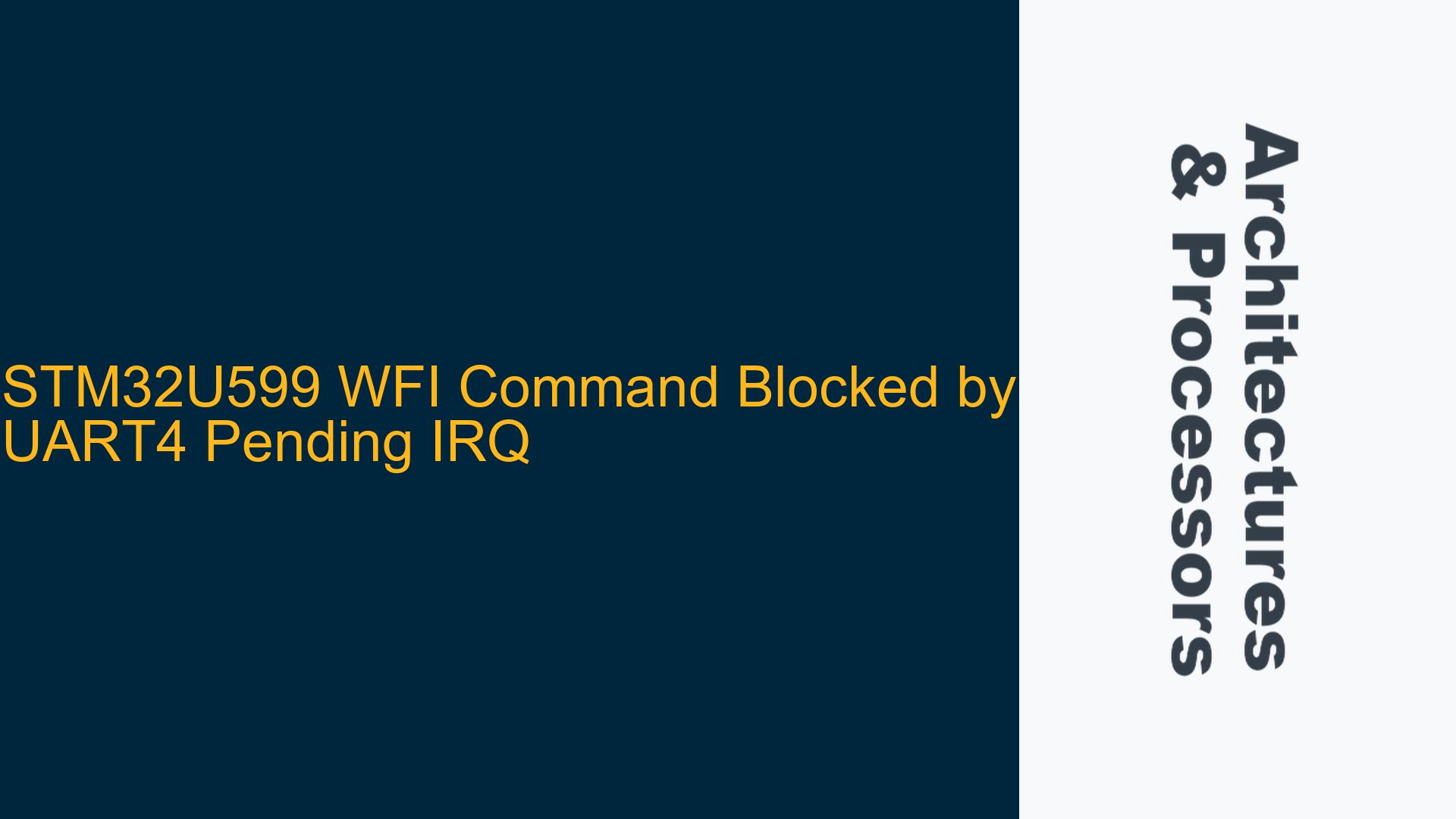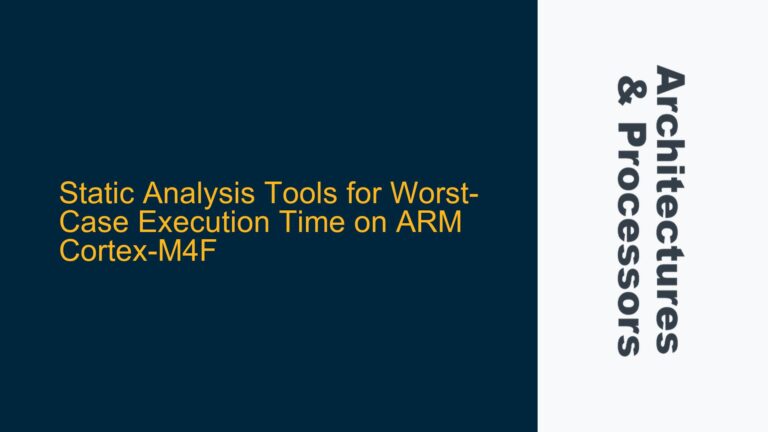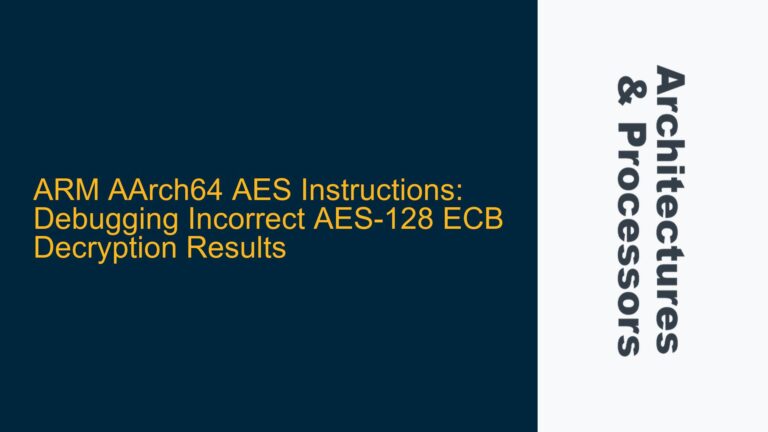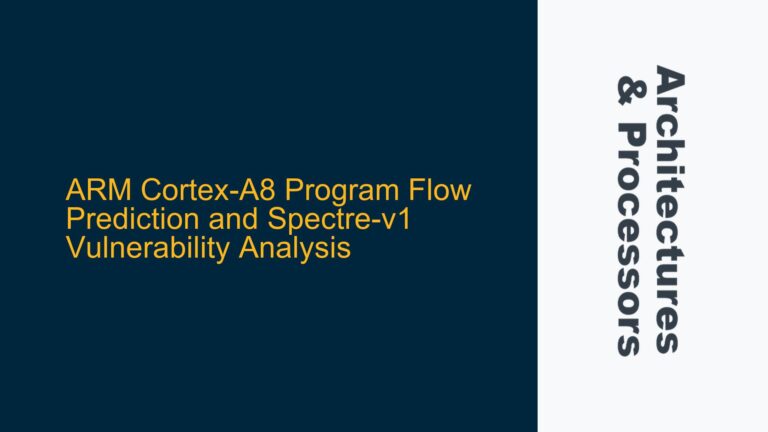ARM Cortex-M33 WFI Behavior and UART4 Pending Interrupt Issue
The STM32U599 microcontroller, based on the ARM Cortex-M33 core, is designed to provide low-power operation through the use of the WFI (Wait for Interrupt) instruction. The WFI instruction is a critical feature for power-sensitive applications, as it allows the CPU to enter a low-power state until an interrupt occurs. However, in the case of the STM32U599, users have reported that the WFI instruction fails to enter standby mode due to a pending UART4 interrupt, even when UART4 is not explicitly enabled or used in the application. This behavior raises questions about the root cause of the pending interrupt and its impact on the WFI instruction.
The ARM Cortex-M33 core implements the WFI instruction as part of its power management capabilities. When the WFI instruction is executed, the CPU halts execution and enters a low-power state, waiting for an interrupt to wake it up. However, if there is a pending interrupt at the time the WFI instruction is executed, the CPU will not enter the low-power state. Instead, it will immediately resume execution, effectively rendering the WFI instruction ineffective. This behavior is by design, as the presence of a pending interrupt indicates that there is work to be done, and the CPU should not enter a low-power state.
In the case of the STM32U599, the UART4 interrupt is reported as pending, even though UART4 is not explicitly enabled or used in the application. This suggests that the UART4 peripheral is generating an interrupt request, which is then flagged as pending in the NVIC (Nested Vectored Interrupt Controller). The NVIC is responsible for managing interrupts on the Cortex-M33 core, and it maintains a register of pending interrupts. When an interrupt is pending, the NVIC will prevent the CPU from entering a low-power state via the WFI instruction until the pending interrupt is cleared.
The presence of a pending UART4 interrupt on the STM32U599, despite the peripheral not being used, indicates that there may be an issue with the default configuration of the UART4 peripheral or with the initialization code in the application. It is also possible that the UART4 peripheral is generating spurious interrupts due to hardware or configuration issues. Understanding the root cause of this behavior is essential for ensuring that the WFI instruction functions as intended and that the microcontroller can enter low-power modes when required.
UART4 Peripheral Default Configuration and Spurious Interrupts
The UART4 peripheral on the STM32U599 microcontroller may have a default configuration that enables certain interrupt sources, even if the peripheral is not explicitly enabled by the user. This default configuration could be responsible for the pending UART4 interrupt that is blocking the WFI instruction. Additionally, spurious interrupts may be generated due to hardware issues, such as noise on the UART4 pins or incorrect pin configurations.
The UART4 peripheral on the STM32U599 is a complex module that supports various communication protocols and features. By default, the UART4 peripheral may have certain interrupt sources enabled, such as the transmit complete interrupt or the receive data available interrupt. These interrupt sources can generate interrupt requests if the corresponding conditions are met, even if the UART4 peripheral is not actively being used. For example, if the UART4 transmit buffer is empty, a transmit complete interrupt may be generated, which would then be flagged as pending in the NVIC.
In addition to default interrupt configurations, spurious interrupts may be generated due to hardware issues. For example, if the UART4 pins are not properly configured or if there is noise on the UART4 lines, the UART4 peripheral may generate interrupt requests erroneously. These spurious interrupts can then prevent the WFI instruction from entering standby mode, as the NVIC will detect the pending interrupt and prevent the CPU from entering a low-power state.
To determine whether the pending UART4 interrupt is due to a default configuration or spurious interrupts, it is necessary to examine the UART4 peripheral registers and the NVIC pending interrupt register. The UART4 control registers should be checked to determine which interrupt sources are enabled, and the NVIC pending interrupt register should be examined to confirm the source of the pending interrupt. Additionally, the UART4 pin configurations should be verified to ensure that they are correctly set up and that there is no noise or interference on the UART4 lines.
Clearing Pending UART4 Interrupts and Ensuring Proper WFI Operation
To resolve the issue of the pending UART4 interrupt blocking the WFI instruction on the STM32U599, it is necessary to clear the pending interrupt before executing the WFI instruction. This can be done by writing to the NVIC pending interrupt register to clear the UART4 interrupt flag. Additionally, the UART4 peripheral should be properly configured to ensure that it does not generate spurious interrupts.
Clearing the pending UART4 interrupt can be achieved by writing to the NVIC pending interrupt register. The NVIC pending interrupt register is a memory-mapped register that allows software to clear pending interrupts. By writing a ‘1’ to the bit corresponding to the UART4 interrupt in the NVIC pending interrupt register, the pending interrupt flag can be cleared, allowing the WFI instruction to enter standby mode as intended. This step should be performed before executing the WFI instruction to ensure that there are no pending interrupts that could prevent the CPU from entering a low-power state.
In addition to clearing the pending interrupt, the UART4 peripheral should be properly configured to prevent the generation of spurious interrupts. This includes ensuring that the UART4 interrupt sources are disabled if the peripheral is not being used. The UART4 control registers should be examined to determine which interrupt sources are enabled, and any unnecessary interrupt sources should be disabled. For example, if the UART4 transmit complete interrupt is enabled by default, it should be disabled if the UART4 peripheral is not being used for transmission.
Furthermore, the UART4 pin configurations should be verified to ensure that they are correctly set up and that there is no noise or interference on the UART4 lines. If the UART4 pins are not being used, they should be configured as GPIO inputs with pull-up or pull-down resistors to prevent floating inputs, which can cause spurious interrupts. Additionally, any noise or interference on the UART4 lines should be mitigated through proper PCB layout and filtering.
By clearing the pending UART4 interrupt and properly configuring the UART4 peripheral, the WFI instruction can be used effectively to enter low-power modes on the STM32U599 microcontroller. This ensures that the microcontroller can achieve the desired power savings while maintaining reliable operation.
Detailed Analysis of UART4 Peripheral Registers and NVIC Configuration
To further understand the issue of the pending UART4 interrupt on the STM32U599, it is necessary to delve into the specifics of the UART4 peripheral registers and the NVIC configuration. The UART4 peripheral on the STM32U599 is controlled through a set of memory-mapped registers that configure its operation, including interrupt generation. The NVIC, on the other hand, is responsible for managing interrupts on the Cortex-M33 core and maintains a set of registers that control interrupt prioritization, enablement, and pending status.
The UART4 peripheral registers include the Control Register (UART4_CR), the Status Register (UART4_SR), and the Interrupt Enable Register (UART4_IER). The UART4_CR register controls the overall operation of the UART4 peripheral, including enabling or disabling the transmitter and receiver. The UART4_SR register provides status information about the UART4 peripheral, such as whether the transmit buffer is empty or whether data has been received. The UART4_IER register controls which interrupt sources are enabled, such as the transmit complete interrupt or the receive data available interrupt.
By default, the UART4_IER register may have certain interrupt sources enabled, even if the UART4 peripheral is not explicitly enabled by the user. For example, the transmit complete interrupt may be enabled by default, which would cause an interrupt to be generated when the transmit buffer is empty. This interrupt would then be flagged as pending in the NVIC, preventing the WFI instruction from entering standby mode.
The NVIC maintains a set of registers that control interrupt management on the Cortex-M33 core. The NVIC Interrupt Set-Enable Register (NVIC_ISER) is used to enable interrupts, while the NVIC Interrupt Clear-Enable Register (NVIC_ICER) is used to disable interrupts. The NVIC Interrupt Set-Pending Register (NVIC_ISPR) is used to set interrupts as pending, while the NVIC Interrupt Clear-Pending Register (NVIC_ICPR) is used to clear pending interrupts.
To clear the pending UART4 interrupt, the NVIC_ICPR register should be used. By writing a ‘1’ to the bit corresponding to the UART4 interrupt in the NVIC_ICPR register, the pending interrupt flag can be cleared. This should be done before executing the WFI instruction to ensure that there are no pending interrupts that could prevent the CPU from entering a low-power state.
Practical Steps for Debugging and Resolving the Issue
To debug and resolve the issue of the pending UART4 interrupt on the STM32U599, the following practical steps should be taken:
-
Review the UART4 Peripheral Configuration: Examine the UART4 control registers (UART4_CR, UART4_SR, and UART4_IER) to determine which interrupt sources are enabled. Disable any unnecessary interrupt sources, such as the transmit complete interrupt or the receive data available interrupt, if the UART4 peripheral is not being used.
-
Check the NVIC Pending Interrupt Register: Examine the NVIC pending interrupt register (NVIC_ISPR) to confirm the source of the pending interrupt. If the UART4 interrupt is pending, clear it by writing to the NVIC_ICPR register.
-
Verify UART4 Pin Configurations: Ensure that the UART4 pins are properly configured. If the UART4 pins are not being used, configure them as GPIO inputs with pull-up or pull-down resistors to prevent floating inputs, which can cause spurious interrupts.
-
Mitigate Noise and Interference: If the UART4 pins are being used, ensure that there is no noise or interference on the UART4 lines. This can be achieved through proper PCB layout and filtering.
-
Implement a Pre-WFI Interrupt Clear Routine: Before executing the WFI instruction, implement a routine that clears any pending interrupts, including the UART4 interrupt. This ensures that the CPU can enter standby mode without being hindered by unwanted interrupt requests.
By following these steps, the issue of the pending UART4 interrupt blocking the WFI instruction on the STM32U599 can be effectively resolved, allowing the microcontroller to achieve the desired power savings while maintaining reliable operation.
Conclusion
The issue of the pending UART4 interrupt blocking the WFI instruction on the STM32U599 microcontroller is a complex problem that requires a thorough understanding of the UART4 peripheral configuration, the NVIC interrupt management system, and the ARM Cortex-M33 core’s power management features. By carefully reviewing the UART4 peripheral registers, clearing pending interrupts, and ensuring proper pin configurations, the issue can be resolved, allowing the WFI instruction to function as intended. This ensures that the STM32U599 microcontroller can achieve the desired low-power operation while maintaining reliable performance.






